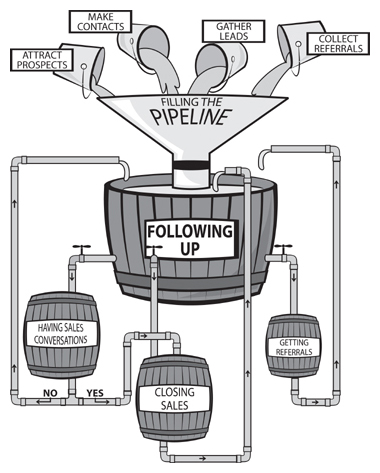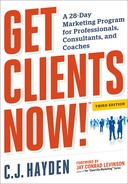THE UNIVERSAL MARKETING CYCLE
Marketing and sales for the professional services business operates on a predictable cycle, with four separate stages:
1. Filling the Pipeline
2. Following Up
3. Having Sales Conversations
4. Closing Sales
The activities that take place within each stage of the cycle will vary depending on your business, but the cycle is the same for everyone. Knowing more about how this cycle works will enable you to determine exactly where to focus more time and energy in your marketing.
Figure 2-1 depicts the Universal Marketing Cycle as if it were a water system. At the top are the collection buckets for the prospects, contacts, leads, and referrals with which you are filling the pipeline. On your desk, computer, or favorite handheld device, these will be represented by the names and phone numbers of people and organizations. Prospects are people you have reason to believe will be interested in your services. Contacts are people you meet through outreach strategies like networking, or just in the course of business or life. Leads are people you identify through research or hear about from your contacts. And referrals are people who are referred to you by contacts, clients, and others.
Figure 2-1: The Universal Marketing Cycle

Don’t worry too much about the distinctions among these categories. They are all people in your pipeline.
The marketing pipeline empties into the follow-up pool, which you dip into in order to move potential clients and referral sources further along in the system. They don’t move along by themselves; you must make this happen. Your goal is to keep the follow-up pool constantly circulating, with new prospects entering the pipeline and existing ones flowing into the next stage of the cycle.
The arrows in the bottom half of the diagram indicate the direction of flow. With potential clients, you want to move quickly to having a sales conversation. This is where you find out about their needs, tell them more about what you do, and see if there is a match between the two of you. The actual conversation may happen in a formal presentation or scheduled appointment, or informally, in person, by telephone, or even by e-mail. Some professionals offer a complimentary consultation or sample session as a lead-in to a sales conversation. When the sales conversation concludes, you may be ready to ask for the business, or you may need to prepare a detailed proposal first. In some cases, the conversation stage may last 15 minutes, and in others, it can take many months.
Your desired result, though, is always the same: to move prospects forward to closing the sale. If they say yes at the end of the sales conversation, you have a new client. If they say no, they stay in the closing sales stage, where you continue to follow up with them as long as it seems worthwhile. Sometimes continued follow-up will lead directly to closing the sale after all, and at other times, you may need to have yet another sales conversation.
When the sale is closed, you begin to serve the client. As you are providing service, and after you complete your service, the client must also return to the follow-up pool. By continuing to follow up with this client, you may close another sale or get referrals.
Some of the people and organizations in your pipeline may never enter the prospect area of the cycle at all. They may be contacts who can become referral sources for you. You must follow up with these people also, regularly reminding them that you are around, thanking them for referrals, and putting them right back in the follow-up pool.
In any of these cases, what follow-up looks like and how often it happens depends on the nature of your business and the type of contact that seems natural for you. Refer to the tactics listed in the previous chapter under direct contact and follow-up. Every one of these is a potential followup technique.
